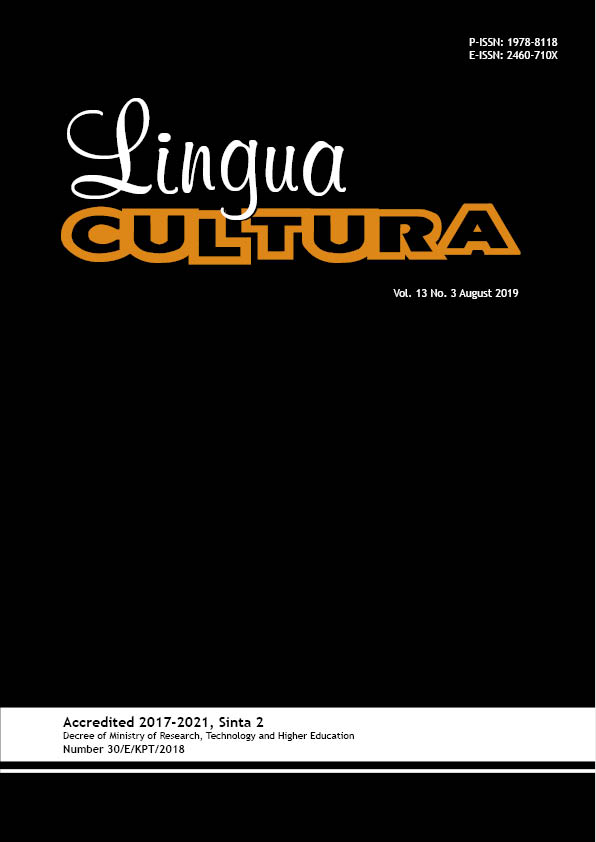The Representation of Women’s CEO Image in Online Media
DOI:
https://doi.org/10.21512/lc.v13i3.5785Keywords:
women representation, women image, online media, critical discourse analysisAbstract
The research focused on the representation of women in the news about the absence of women in Uber’s CEO candidates from the perspective of feminist stylistics by Sara Mills. Five news texts from five different websites published during August 2017 were analyzed; they were Washington Post, Daily Mail, Inverse, Gizmodo, and Fortune. The method used was a qualitative research method with the approach of critical discourse analysis of Sara Mills. By applying three levels of analysis which was analysis at the level of the word, phrase/sentence, and discourse, this research aimed to analyze how women were represented linguistically in the online news of Uber’s CEO candidates and to discover the reason why women were represented in the way they were. The findings reveal that women remain underrepresented in news media. It is proved by the dominance of women as the object in the stories. Moreover, women are represented as ‘glass cliff position’, minority, and a way to recreate the good image in the company. The gender stereotypes, the background story of Uber, the male-dominated industries, and the prevalent condition become the reasons why women represented that way.
References
Ali, R., & Batool, S. (2015). Stereotypical identities: Discourse analysis of media images of women in Pakistan. Multidisclipinary Journal of Gender Studies, 4(1), 690–717. https://doi.org/10.4471/
generos.2015.54.
Aznar, M. P. M., RodrÃguez-Wangüemert, C., & Espinosa Morales, I. E. (2017). Portrayal of women and men in Spanish press. Revista Latina de Comunicación Social, 72, 765–782. https://doi.org/10.4185/RLCS,72-2017-1191en.
Baden, C., & Tenenboim-Weinblatt, K. (2016). Viewpoint, testimony, action. Journalism Studies, 19(1), 143–161. https://doi.org/10.1177/1464884907078659.
Bruckmuller, S., Ryan, M. K., Rink, F., & Haslam, S. A. (2014). Beyond the glass ceiling: The glass cliff and its lessons for organizational policy. Social Issues and Policy Review, 8(1), 202–232. https://doi.org/10.1111/sipr.12006.
Darta, D. M. S., & Kristina, D. (2018). The representation of women characters in the movie â€The Breadwinnerâ€. International Journal of Humanity Studies, 2(1), 42–50. https://doi.org/10.24071/ijhs.2018.020105.
Darweesh, A. D., & Abdullah, N. M. (2016). A critical discourse analysis of Donald Trump’s sexist ideology. Journal of Education and Practice, 7(30), 87–95.
Geertsema-Sligh, M. (2019). Gender issues in news coverage. In The International Encyclopedia of Journalism Studies (pp 1–8). New Jersey: John Wiley & Sons, Inc. https://doi.org/10.1002/9781118841570.iejs0162.
Jia, S., Landdall-Welfare, T., Sudhahar, S., & Carter, C. (2016). Women are seen more than heard in online newspapers. PLoS ONE, 11(2), 1–11. https://doi.org/doi:10.1371/journal.pone.0148434.
Kristina, D. (2019). Analisis wacana kritis: Pengantar praktis. Jakarta: Akademi Sekolah Darurat Kartini.
Len-Rios, M. E., Rodgers, S., Thorson, E., & Yoon, D. (2005). Representation of women in news and photos: Comparing content to perceptions. Journal of Commmunication, 55(1), 152–168. https://doi.org/10.1111/j.1460-2466.2005.tb02664.x.
Mills, S. (1988). Feminist stylistics. London: Routledge.
Mills, S. (1998). Post-feminist text analysis. Language and Literature 7(3), 235-252. https://doi.org/10.1177/096394709800700304.
Newman, N., Fletcher, R., Kalogeropoulos, A., Levy, D. A. L., & Nielsen, R. K. (2017). Reuters institute digital news report 2017. Oxford: Reuters Institute for the Study of Journalism.
Ramanathan, R. (2015). Application of critical discourse analysis in media discourse studies. The Southeast Asian Journal of English Language Studies, 21(2), 57–68.
Ryan, K. (2013). The media’s war on women: Gendered coverage of female candidates. Xavier Journal of Politics, 4(1), 13–25.
Shor, E., Van de Rijt, A., Miltsov, A., Vivek, K., & Skiena, S. (2015). A paper ceiling: Explaining the persistent underrepresentation of women in printed news. American Sociological Review, 80(5), 960–984. https://doi.org/10.1177/0003122415596999.
Suryaningrum, S., Suwandi, S., & Waluyo, H. J. (2019). The discrimination against women reflected in novels â€Entrokâ€, â€Maryamâ€, and â€Pasung Jiwa†by Okky Madasari. Lingua Cultura, 13(2), 137–143. https://doi.org/10.21512/lc.v13i2.5704.
Van Dijk, T. A. (2015). Critical discourse analysis. In D. Tannen, H. E. Hamilton, & D. Schiffrin (Eds.), The Handbook of Critical Discourse Analysis (Second edition, pp. 466–485). New Jersey: John Wiley &
Sons, Inc. https://doi.org/10.1002/9781118584194.ch22.
Downloads
Published
How to Cite
Issue
Section
License
Authors who publish with this journal agree to the following terms:
a. Authors retain copyright and grant the journal right of first publication with the work simultaneously licensed under a Creative Commons Attribution License - Share Alike that allows others to share the work with an acknowledgment of the work's authorship and initial publication in this journal.
b. Authors are able to enter into separate, additional contractual arrangements for the non-exclusive distribution of the journal's published version of the work (e.g., post it to an institutional repository or publish it in a book), with an acknowledgment of its initial publication in this journal.
c. Authors are permitted and encouraged to post their work online (e.g., in institutional repositories or on their website) prior to and during the submission process, as it can lead to productive exchanges, as well as earlier and greater citation of published work.
USER RIGHTS
All articles published Open Access will be immediately and permanently free for everyone to read and download. We are continuously working with our author communities to select the best choice of license options, currently being defined for this journal as follows: Creative Commons Attribution-Share Alike (CC BY-SA)


















